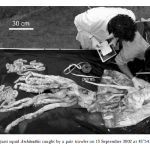The new squid diva is 24ft long. How does she measure up? I just happen to have data sitting on my computer to address that issue. Don’t ask...I lay awake at night thinking about the body size of marine organisms. Below is a histogram of every documented Architeuthis capture before 1997 (data are from The Search for the Giant Squid).
 You can see the new capture follows slightly below the average. Molluscs (clams, oysters, scallops, chitons, tusk shells, squid, octopods, nautilus, snails, slugs) are fascinating group in general with respect to body size. Body sizes vary over 12 orders of magnitude in volume from the smallest gastropods (snails and slugs; such as <0.2 mm3 Carychium nannodes, a terrestrial land snail, from North America) to the largest cephalopods (ca. 2.2 x 1011 m3 for the giant squid Architeuthis dux). Why the remarkable range in size?
You can see the new capture follows slightly below the average. Molluscs (clams, oysters, scallops, chitons, tusk shells, squid, octopods, nautilus, snails, slugs) are fascinating group in general with respect to body size. Body sizes vary over 12 orders of magnitude in volume from the smallest gastropods (snails and slugs; such as <0.2 mm3 Carychium nannodes, a terrestrial land snail, from North America) to the largest cephalopods (ca. 2.2 x 1011 m3 for the giant squid Architeuthis dux). Why the remarkable range in size?
As noted by Barnes et al. (1993) “Their success is probably not so much attributable to any particular special anatomical or ecological features of the group as to the extreme plasticity and adaptability of the basic molluscan body plan.” As an example to this consider, the radiation of the mollusca includes the obvious addition of an exoskeleton but also subsequent major modifications by coiling, reduction, duplication, segmentation, and in multiple independent events the ultimate loss of the shell. The phylum possesses groups with specialized neural systems and two fundamentally different respiratory systems. Most feeding styles are known from within the group, including parasitism and symbiotic mutualisms (including coral reef zooxanthellae and hydrothermal vent chemosynthetic bacteria). Reproductive biology varies from sexual dimorphism to hermaphrodism, with uniparental mating being common in some species.
text from McClain and Nekola in press





